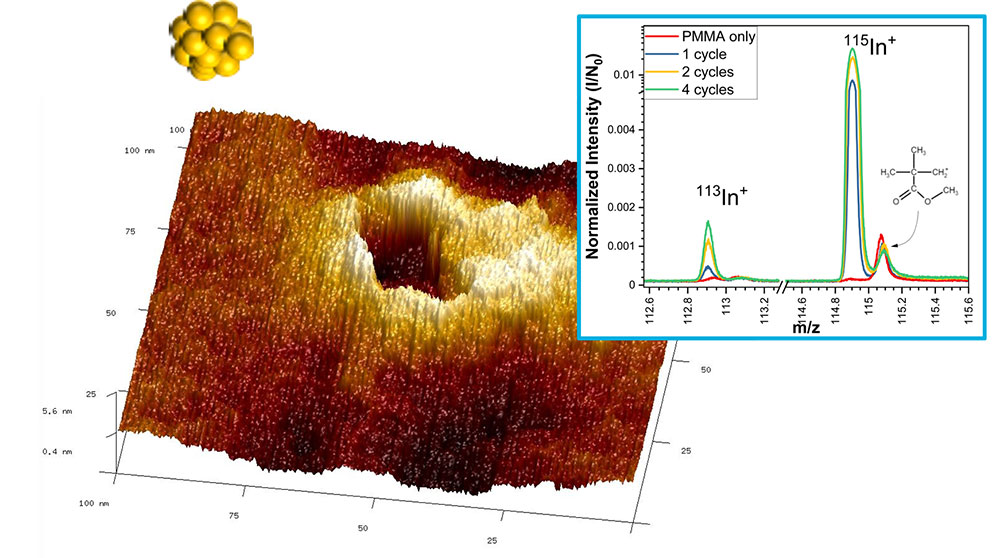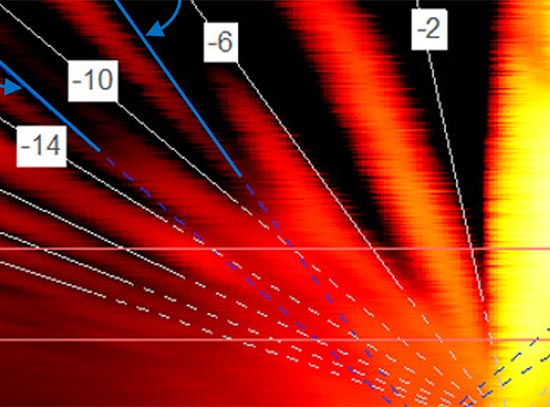Insights into EUV Resist Molecular Uniformity through Nano-Projectile SIMS
October 21, 2025
 enlarge
enlarge
A few nm impact crater created by a single (Au400)4+ nanoprojectile on InOx-PMMA hybrid resist surface & a resulting SIMS spectrum.
Scientific Achievement
It was demonstrated that nano-projectile secondary ion mass spectrometry (NP-SIMS) can resolve chemo-spatial molecular non-uniformity of organic-inorganic hybrid photoresists synthesized by vapor-phase infiltration (VPI).
Significance and Impact
This capability provides a powerful new method for understanding and optimizing hybrid resists—key materials for advancing extreme ultraviolet (EUV) lithography in next-generation semiconductor manufacturing.
Research Details
Next-generation extreme-ultraviolet (EUV) lithography demands hybrid photoresists that marry high-Z loading for absorption with excellent etch resistance, yet a persistent bottleneck is metrology: most tools cannot simultaneously probe organic and inorganic components with a few nm lateral sensitivity to judge nanoscale uniformity—the property that ultimately governs critical dimension uniformity, line-edge roughness, and eventual patterning resolution. Researchers from California State University, Northridge (CSUN), Stony Brook University, and the Center for Functional Nanomaterials (CFN) at Brookhaven National Laboratory demonstrate an event-by-event Nano-Projectile Secondary Ion Mass Spectrometry (NP-SIMS) approach that samples a few nm scale volumes separated by time and space across resist films and quantifies chemical homogeneity. Using indium oxide infiltrated PMMA hybrid thin film, a model EUV resist developed by CFN using vapor-phase infiltration (VPI) technique, NP-SIMS detects rich, component-specific ion signatures from both the polymer and the metal-oxide network, resolving indium ions from nearby PMMA fragments. Indium atomic-ion yield scales linearly with infiltration cycles, while correlation-based homogeneity analysis reveals that the first infiltration cycle induces pronounced inhomogeneity in both PMMA and indium that recovers toward uniformity with additional cycles. This establishes NP-SIMS as a rapid, chemically specific nanometrology for hybrid EUV resists—providing actionable feedback to tune VPI chemistry and cycle count for uniform high-Z loading, and charting a path to direct correlations with EUV patterning performance.
- An InOx-infiltrated PMMA hybrid EUV resist was prepared using VPI, an organic-inorganic hybridization method derived from atomic layer deposition.
- NP-SIMS performed 106 – 107 discrete mass-spectral samplings separated by time and space using (Au400)4+ nanoprojectiles, revealing how molecular uniformities of the hybrid resist components evolve with infiltration cycles.
- NP-SIMS revealed improving molecular homogeneity with repeated cycles & characteristic ions from infiltration reactions, giving mechanistic insight into hybrid material formation.
Publication Reference
G. Swieca, W.-I. Lee, S. Ha, N. Tiwale, C.-Y. Nam, M.J. Eller*, “Inspection of next-generation EUV resists with nano-projectile secondary ion mass spectrometry” Journal of Micro/Nanopatterning, Materials, and Metrology (JM3) 24, 024003 (2025).
DOI: https://doi.org/10.1117/1.JMM.24.2.024003
Acknowledgment of Support
This research used the Materials Synthesis and Characterization Facility of the Center for Functional Nanomaterials (CFN), which is a U.S. Department of Energy Office of Science User Facility, at Brookhaven National Laboratory under Contract No. DE-SC0012704. The authors acknowledge support from the U.S. Department of Energy Office of Science Accelerate Initiative Award 2023-BNL-NC033-Fund.
2025-22697 | INT/EXT | Newsroom









